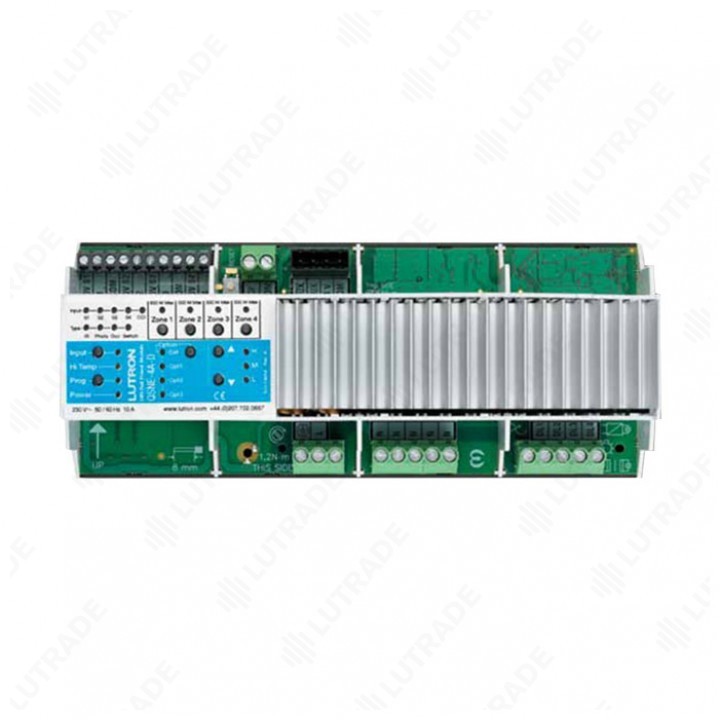HWQS 4-канальный адаптивный диммер для установки на DIN-рейку (QSNE-4A-D)
- Производитель: Lutron
- Код товара: QSNE-4A-D
- Артикул: QSNE-4A-D
Energi Savr Node QS Phase Adaptive
Fixture Controller The Energi Savr Node QS family is a group of modular products for the control of lighting loads. This product is compatible with Quantum and QS systems.
Features
• Automatically selects leading-edge or trailing-edge
dimming for incandescent / halogen, electronic/magnetic
low-voltage and neon/cold cathode light sources.
• Controls dimmable CFL / LED loads. Refer to Lutron
P/N 048478 on www.lutron.com for compatibility with
dimmable CFL / LED light sources.
• RTISS Equipped technology compensates for
incoming line-voltage variations (up to ± 2% change
in frequency/second) such as changes in Root Mean
Square (RMS) voltage, frequency shifts, harmonics and
line noise.
• RTISS-TE operates on the trailing edge of the AC
sine wave. This allows for true instantaneous voltage
compensation.
Unit is 12 DIN modules (216 mm) wide.
• Four multi-function inputs compatible with the following:
– Daylight sensors
– Occupancy sensors
– IR receivers
– IEC PELV / NEC®
– Class 2 dry contact switches
• Provides air gap off (when all zones are off).
• Integral protection for common temporary overcurrent and over-voltage conditions.
• LEDs on front of unit provide diagnostic information.
• Includes QS link for seamless integration of lights and controls.
Power
• 220–240 V ~ 50/60 Hz
• 10 A maximum total input current
• Lightning strike protection meets ANSI/IEEE standard 62.31-1980. Can withstand voltage surges of up to 6 000 V and current surges of up to 3 000 A.
• 24 V - 132 mA, 4 PDUs supplied
Regulatory Approvals
• IEC/EN 60669-2-1
• CE marked
• Lutron Quality Systems registered to ISO 9001.2008
Environment
• See Mounting section for thermal specifications
• Relative humidity: less than 90% non-condensing
• For indoor use only
Output Zone Ratings
• No Derating is required if all the conditions below are met:
– Calibration point maximum is 70 ?C
– Room ambient temperature is between 0 ?C and 30 ?C
– Panel ambient temperature is between 0 ?C and 50 ?C
• 100 W Derating is required on all zones for a single module in a single non-ventilated DIN enclosure if:
– The room ambient temperature is between 30 ?C and 40 ?C.
• 200 W Derating is required on all zones for multiple row non-ventilated DIN enclosure if:
– The room ambient temperature is between 30 ?C and 40 ?C.
Output Zone Ratings (continued)
• Each zone has no minimum load requirement.
• Automatically selects leading-edge or trailing-edge dimming or can also be manually configured for a specific load type.
• Internal relay provides an air gap off when all zones are off.
• One load type per zone.
• Output must not be used to control receptacles.
• Output must be directly connected to the load. Contact Lutron for applications with load side breakers.
• Run a separate neutral for each load circuit. A common neutral connection is not recommended.
• Maximum wire length between the Energi Savr Node unit and the load must be less than 30.5 m.
• Unit may be powered by Ground Fault Interrupter (GFI) or Residual Current Circuit Breaker with Overload (RCBO) protected circuit if required. Load circuit wiring (from breaker to unit to load) must be run in its own non metallic conduit, or nuisance tripping may occur.
• For applications requiring 0–10 Vcontrol, use Ten Volt Interface (GRX-TVI) or the QSNE-4T10-D.
• For applications requiring higher wattage ratings, use a power booster (NGRX-PB, NGRX-ELVI, NGRX-FDBI).
Multi-Function Inputs
• Each multi-function input is compatible with occupancy and daylights sensors as well as IR receivers and IEC PELV / NEC Class 2 dry contact switches.
• Dedicated Power Supply Output for each input –20 V- 50 mA maximum each.– An auxiliary supply is required if an input requires more than 50 mA.
Wired Occupancy Sensors
• Each of the inputs can power one Lutron occupancy sensor, up to four sensors per unit.
• Lutron occupancy sensors can be configured to have one of the following modes:
– Occupancy: Automatic On, Automatic Off
– Vacancy: Manual On, Automatic Off
• Each area’s occupied and unoccupied scene can be configured independently.
• Each occupancy sensor can control one or more zones.
• Occupancy sensor must provide a dry contact closure or solid-state output.
• Each unit may be controlled by occupancy sensors connected to other devices, up to a maximum of sixteen occupancy sensors.
Wired Infrared (IR) Receivers
• Each of the inputs can power one IR receiver, up to
four receivers per unit.
• Use Lutron IR receivers and compatible transmitters
for personal control of individual lighting zones.
Wired Daylight Sensors
• Each of the inputs can power one daylight sensor, up to four sensors per unit.
• Lutron daylight sensors allow daylight harvesting and can be programmed to affect light output.
• Use Lutron EC-DIR-WH sensors to control one or more zones.
• Each zone may be controlled by a maximum of two daylight sensors.
Dry Contact Switches
• Must be rated for IEC PELV / NEC Class 2 operation.
• Can be configured for momentary or maintained operation.
• Zones can be programmed to any level including Off.






